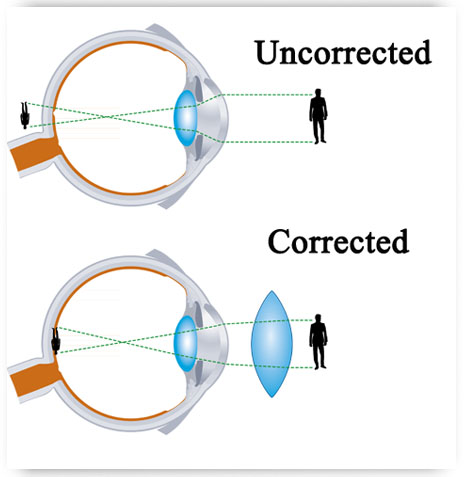Human Eye :-
The human eye is the most complicated Sense organ in the body with several parts fixed together form a spherical structure.
Our eye is one of the most important optical device the nature has endowed us with.

Sclerotic :-
It is a tough and thick white sheat that protects the inner parts of the human eye.
Conjunctiva is a thin transparent membrane that is spread across the sclerotic. It keeps the eyes moist and clear by secreting small amount of mucus and tears.
Cornea :-
It is the transparent layer of skin that is spread over the Pupil and the Iris, the main role of the Cornea is to refract the light that enters the human eye.
Iris :-
It is a pigment layer of tissues that make up the colour portion of the human eye. Its primary function is to control the size of the pupil, depending on the amount of light entering it.
Pupil :-
It is the small opening located at the middle of the Iris. It allows light to come in.
The size of The Pupil can change under control of muscles.
Lens :-
It is a transparent, biconvex and an adjustable part of a human eye. The lens with the help of cornea refracts light focused on the retina, therefore creating images on it.
Retina :-
It is the layer present at the back of the eye where all the images are formed. It is the third and inner coat of the eye which is very sensitive towards the right because of the presence of photoreceptors.
The retina function by converting the light rays into impulse and sending the signals to the brain through the optic nerve.
Optic nerve :-
It is located at the end of the human eye behind the retina. The optic nerve is mainly responsible for carrying all the nerve impulses from the photoreceptors to the human brain.
Aqueous humour :-
It is a watery fluid that is present in the area between the lens and the cornea. It is responsible for the nourishment of both the lens and the cornea.
Vitreous humour :-
It is a semi-solid, transparent, Jelly like substance that covers the interior portion of the eyes. It plays an important role in maintaining the shape of the human eye and also causes refraction of light before it reaches the retina.
Power of Accommodation :-
When the object is brought closer to the human eye in order to maintain the same image – lens distance ( 2.5 cm ), the focal length of the human eye lens becomes shorter by the action of the ciliary muscles. This property of the eye is called accommodation.
Least distance of distinct Vision :-
The closest distance for which the lens can focus light on the retina is called the least distance of distinct vision or near point. The standard value for normal vision is taken as 25 cm. The near point is given the symbol D.
Far point :-
The farthest point up to which the human eye can see objects clearly is called the far point of the eye. It is infinity for a normal eye. A normal human eye can see object clearly that are between 25 cm and infinity.
Defects of Vision :-
There are four common defects of human eye.
1. Myopia or short sightedness.
2. Hypermetropia or long sightedness.
3. Presbyopia.
4. Astigmatism.
Myopia :-
It is a defect of vision wherein far-off objects appear blurred and objects near are seen clearly. Since the eyeball is too long or the eye lens’s refractive power is too high.
The lens may be thicker ( more conversing ).

- The image forms in front of the retina rather than forming on it.
- Correction of myopia can happen by wearing glasses / contacts made of concave lenses ( diverging lenses ) to help focus the image on the retina.
If distance of far point ‘d’
Object distance for glass ‘u’ = – ∞ ( infinite )
image distance ‘v’ = – d
focal length for concave lens ‘f’
then 1 / f = ( 1 / – d ) – ( 1 / – ∞ )
Power ‘ P ‘ = 1 / – d Diopter
P = 100 / – d ( in cm )
Hypermetropia :-
It is a defect of vision where in there is difficulty in viewing objects that are near but one can view far object easily. Since the eyeball is too short or eye lens’s refractive power is too weak the eye lens may be thinner hence the image instead is of being forming upon the retina.

- Correction of hypermetropia can happen by wearing glasses / contacts containing convex lenses ( converging lenses ).
If focal length of convex lens ‘f’, object distance ‘u’ = – D and image distance ‘v’ = – d then
1 / f = ( 1 / v ) – ( 1 / u ) = ( 1 / -d ) – ( 1 / -D )
Or 1 / f = ( 1 / D ) – ( 1 / d )
Or f = ( d – D ) / D d
Power of lens –
P = + D d / d – D
Presbyopia :-
It is a natural defect that occurs with the age, The ciliary muscles become weak and are no longer able to adjust the eye lens.
- The human eye muscles become so weak that no longer can a person see nearby objects clearly.
The near point of a person with presbyopia is more than 25 cm.
- A person with presbyopia can also have just myopia or just hypermetropia.
- Correction of presbyopia can happen by wearing bifocal glasses or progressive addition lenses where in the upper portion of lens contains concave lens and lower portion contains a convex lens.


Astigmatism :-
A person suffering from this defect cannot simultaneously focus on both horizontal and vertical lines of wire gauze.
- This defect arises due to the fact that the cornea is not perfectly spherical.
- This defect can be corrected by using cylindrical lens.

Question :- What focal length should the reading spectacles have for a person for whom the least distance of distinct vision is 50 cm ?
Solution –
The distance of normal vision is 25 cm
So if a book is at u = – 25 cm = D
Image distance v = – 50 cm = d
1 / f = ( 1 / D ) – ( 1 / d ) = ( 1 / – 50 ) – ( 1 / – 25 ) = 1 / 50
Or f = + 50 cm ( convex lens ).
Question :- A person can see clearly objects when they lie between 50 cm and 400 cm from his eyes. In order to increase the maximum distance of distinct vision to infinity, the type and power of the correcting lens. The person has to use will be –
Solution –
v = – 400 cm = – 4 m
u = ∞
1 / f = ( 1 / v ) – ( 1 / u ) = ( 1 / -u ) – ( 1 / – ∞ ) = 1 / – u
f = – 4 cm
P = 1 / f = 1 / – u = – 0·25 D











